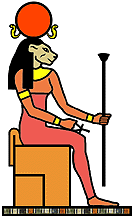Numerous Gods and Goddesses existed within the pantheon of Egyptian religious system. Within this vast religious system, there were different myths regarding the birth of universe as well as its Gods and Goddesses.
Who is the Goddess Tefnut
Tefnut was generally considered as an ancient Egyptian Goddess of moisture, rain and water. There were also some alternative names of Tefnut such as Tefnet, Tefenet etc.

What is the Meaning of Name Tefnut
The name Tefnut comes the words ‘tefen’ that means to split or eject something from the body and ‘nu’ that means ‘sky, waters’. The significance of these meanings can be understood through the myth of her origin.
Heliopolitan view
Tefnut was considered as a part of Heliopolitan view of ancient Egyptian religious system. In the view, the main focus was on the Emergence and the development of Sun god Atum.
Here she is an integral member of ‘Ennade’, the nine, most important gods and goddesses of ancient Egypt in the cosmology of Heliopolitan view.
Origin of the Goddess
According to Heliopolitan view, Tefnut was produced by sun-god Atum. According to different versions of the story, Tefnut was produced from the masturbation of god Atum at the beginning of cosmos.
Tefnut Family Tree
Tefnut and her brother, as well as husband Shu, produced two children that were Geb, the deity of earth and Nut, the deity of the sky. Tefnut had four grandchildren. They were Set, Osiris, Nephthys and Isis.
Solar and Lunar Association
Although she was believed to be originated from the solar origin, she was also associated with the moon. She was portrayed as both the left and right ‘Eyes of Ra’, an auspicious symbol of power and protection in ancient Egypt. Here the left eye symbolizes moon and right eye symbolizes the sun.
She represented moisture as a lunar goddess and dryness as a solar goddess. This is considered as her interesting characteristic. So. it can be assumed that Tefnut may have been represented as the personification of the climatic changes in ancient Egypt.
Shu and Tefnut Story
There is another important myth which has the involvement of Tefnut. That is the myth of ‘Distant Goddess’ or ‘Returning Goddess’. This myth tells the story that once Tefnut became furious with his father, Atum and left Egypt with moisture and rain which caused Egypt dried up.
After that, Shu induced Tefnut, the distant goddess to return with him to Egypt from a mythical foreign land, Nubia, located in the south and east of Egypt. Then Tefnut was purified through ecstatic rites.
According to scholars, this myth actually represents the then present condition of Egypt when it was suffering from drought. This also may have caused the decline of the Old Kingdom.
Iconographic Representation
The appearance of Tefnut came with different types of depiction. Most of the time she is depicted as a human with a head of a lioness. Sometimes she is depicted as fully human or sometimes as a serpent with the head of a lioness.
Solar disc resting on her head in her depiction actually shows her solar origin. Her crown had ‘Uraeus’; the symbol of protection. Like other Egyptian goddesses, Tefnut was depicted in yellowish colour.
She often holds a long stuff, topped with a symbolic animal head. This may have represented an emblem of authority and symbolizes divine power.

There are also some other depictions of Tefnut. She is often depicted holding the Ankh, the key of life, which represents the eternal life. She is sometimes depicted in a double-headed form with her consort Shu on collar counterpoises, a specific type of jewellery. In this form, Shu and Tefnut are known as ‘Ruty’ that means ‘the Two Lions’.

Cult Centre of Tefnut
The major cult centre where Tefnut was worshipped was Heliopolis, Lentopolis etc. There are interesting facts about the city of Lentopolis. It was a city where all the lion-headed and cat-headed deities associated with the sun god Ra, were worshipped.
It was believed that Tefnut and Shu were worshipped as a pair at Lentopolis. The place of their worship was known as ‘Taremu’; the central area of the Nile delta.
Importance of Solar Origin Myth
On the other hand, the worshipping of Tefnut during the reign of Akhenaten gives the suggestion that Atenism, the concept behind the religious changes during the reign of Akhenaten was not at all a monotheistic religion.
It did not deny the existence of other deities and believed in the myth of solar origin about the birth of the universe. That is why Tefnut as a solar deity was given favour during his reign.
